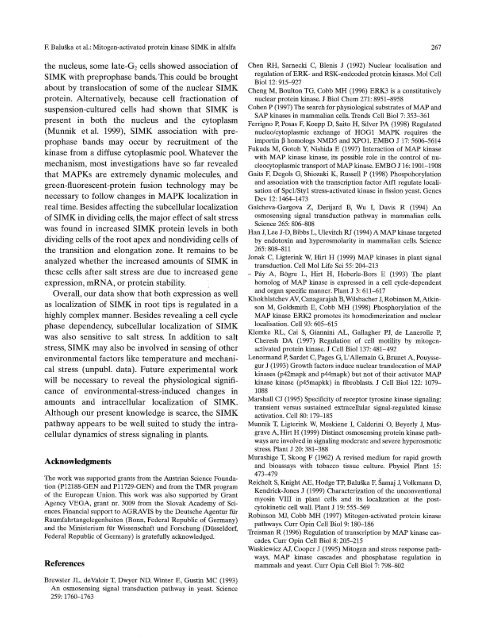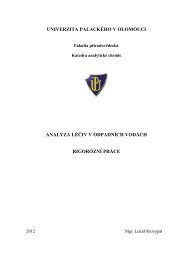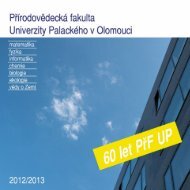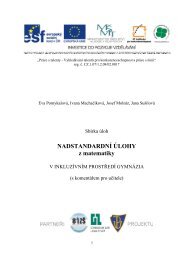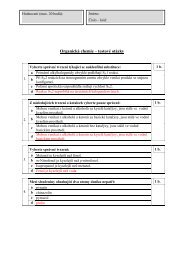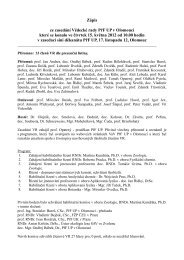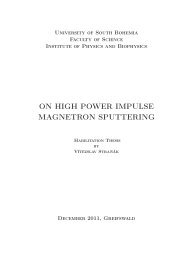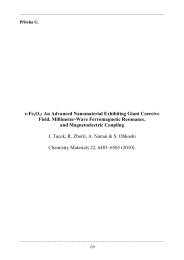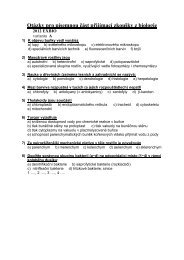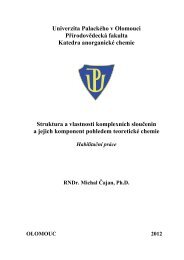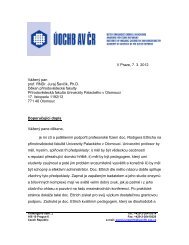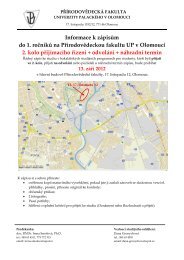A comparative structural analysis of direct and indirect shoot ...
A comparative structural analysis of direct and indirect shoot ...
A comparative structural analysis of direct and indirect shoot ...
You also want an ePaper? Increase the reach of your titles
YUMPU automatically turns print PDFs into web optimized ePapers that Google loves.
E Balugka et al.: Mitogen-activated protein kinase SIMK in alfalfa 267<br />
the nucleus, some late-G2 cells showed association <strong>of</strong><br />
SIMK with preprophase b<strong>and</strong>s. This could be brought<br />
about by translocation <strong>of</strong> some <strong>of</strong> the nuclear SIMK<br />
protein. Alternatively, because cell fractionation <strong>of</strong><br />
suspension-cultured cells had shown that SIMK is<br />
present in both the nucleus <strong>and</strong> the cytoplasm<br />
(Munnik et al. 1999), SIMK association with preprophase<br />
b<strong>and</strong>s may occur by recruitment <strong>of</strong> the<br />
kinase from a diffuse cytoplasmic pool. Whatever the<br />
mechanism, most investigations have so far revealed<br />
that MAPKs are extremely dynamic molecules, <strong>and</strong><br />
green-fluorescent-protein fusion technology may be<br />
necessary to follow changes in MAPK localization in<br />
real time. Besides affecting the subcellular localization<br />
<strong>of</strong> SIMK in dividing cells, the major effect <strong>of</strong> salt stress<br />
was found in increased SIMK protein levels in both<br />
dividing cells <strong>of</strong> the root apex <strong>and</strong> nondividing cells <strong>of</strong><br />
the transition <strong>and</strong> elongation zone. It remains to be<br />
analyzed whether the increased amounts <strong>of</strong> SIMK in<br />
these cells after salt stress are due tO increased gene<br />
expression, mRNA, or protein stability.<br />
Overall, our data show that both expression as well<br />
as localization <strong>of</strong> SIMK in root tips is regulated in a<br />
highly complex manner. Besides revealing a cell cycle<br />
phase dependency, subcellular localization <strong>of</strong> SIMK<br />
was also sensitive to salt stress. In addition to sal t<br />
stress, SIMK may also be involved in sensing <strong>of</strong> other<br />
environmental factors like temperature <strong>and</strong> mechanical<br />
stress (unpubl. data). Future experimental work<br />
will be necessary to reveal the physiological significance<br />
<strong>of</strong> environmental-stress-induced changes in<br />
amounts <strong>and</strong> intracellular localization <strong>of</strong> SIMK.<br />
Although our present knowledge is scarce, the SIMK<br />
pathway appears to be well suited to study the intracellular<br />
dynamics <strong>of</strong> stress signaling in plants.<br />
Acknowledgments<br />
The work was supported grants from the Austrian Science Foundation<br />
(P12188-GEN <strong>and</strong> P11729-GEN) <strong>and</strong> from the TMR program<br />
<strong>of</strong> the European Union. This work was also supported by Grant<br />
Agency VEGA, grant nr. 3009 from the Slovak Academy <strong>of</strong> Sciences.<br />
Financial support to AGRAVIS by the Deutsche Agentur fiir<br />
Raumfahrtangelegenheiten (Bonn, Federal Republic <strong>of</strong> Germany)<br />
<strong>and</strong> the Ministerium fiir Wissenschaft und Forschung (D~sseldorf,<br />
Federal Republic <strong>of</strong> Germany) is gratefully acknowledged.<br />
References<br />
Chen RH, Sarnecki C, Blenis J (1992) Nuclear localisation <strong>and</strong><br />
regulation <strong>of</strong> ERK- <strong>and</strong> RSK-endcoded protein kinases. Mol Cell<br />
Biol 12:915-927<br />
Cheng M, Boulton TG, Cobb MH (1996) ERK3 is a constitutively<br />
nuclear protein kinase. J Biol Chem 271:8951-8958<br />
Cohen P (1997) The search for physiological substrates <strong>of</strong> MAP <strong>and</strong><br />
SAP kinases in mammalian cells. Trends Cell Biol 7:353-361<br />
Ferrigno P, Posas E Koepp D, Saito H, Silver PA (1998) Regulated<br />
nucleo/cytoplasmic exchange <strong>of</strong> HOG1 MAPK requires the<br />
importin [3 homologs NMD5 <strong>and</strong> XPO1. EMBO J 17:5606-5614<br />
Fukuda M, Gotoh Y, Nishida E (1997) Interaction <strong>of</strong> MAP kinase<br />
with MAP kinase kinase, its possible role in the control <strong>of</strong> nucleocytoplasmic<br />
transport <strong>of</strong> MAP kinase. EMBO J 16:1901-1908<br />
Gaits F, Degols G, Shiozaki K, Russell P (1998) Phospohorylation<br />
<strong>and</strong> association with the transcription factor Atfl regulate localisation<br />
<strong>of</strong> Spcl/Styl stress-activated kinase in fission yeast. Genes<br />
Dev 12:1464-1473<br />
Galcheva-Gargova Z, Derijard B, Wu I, Davis R (1994) An<br />
osmosensing signal transduction pathway in mammalian cells.<br />
Science 265:806-808<br />
Han J, Lee J-D, Bibbs L, Ulevitch RJ (1994) A MAP kinase targeted<br />
by endotoxin <strong>and</strong> hyperosmolarity in mammalian cells. Science<br />
265:808-811<br />
Jonak C, Ligterink W, Hirt H (1999) MAP kinases in plant signal<br />
transduction. Cell Mol Life Sci 55:204-213<br />
- Pgty A, B6gre L, Hirt H, Heberle-Bors E (1993) The plant<br />
homolog <strong>of</strong> MAP kinase is expressed in a cell cycle-dependent<br />
<strong>and</strong> organ specific manner. Plant J 3:611-617<br />
Khokhlatchev AV, Canagarajah B, Wilsbacher J, Robinson M, Atkinson<br />
M, Goldsmith E, Cobb MH (1998) Pbosphorylation <strong>of</strong> the<br />
MAP kinase ERK2 promotes its homodimerization <strong>and</strong> nuclear<br />
localisation. Cell 93:605-615<br />
Klemke RL, Cai S, Giannini AL, Gallagher PJ, de Lanerolle P,<br />
Cheresh DA (1997) Regulation <strong>of</strong> cell motility by mitogenactivated<br />
protein kinase. J Cell Biol 137:481-492<br />
Lenorm<strong>and</strong> R Sardet C, Pages G, L'Allemain G, Brunet A, Pouyssegur<br />
J (1993) Growth factors induce nuclear translocation <strong>of</strong> MAP<br />
kinases (p42mapk <strong>and</strong> p44mapk) but not <strong>of</strong> their activator MAP<br />
kinase kinase (p45mapkk) in fibroblasts. J Cell Biol 122: 1079-<br />
1088<br />
Marshall CJ (1995) Specificity <strong>of</strong> receptor tyrosine kinase signaling:<br />
transient versus sustained extracellular signal-regulated kinase<br />
activation. Cell 80:179-185<br />
Munnik T, Ligterink W, Meskiene I, Calderini O, Beyerly J, Musgrave<br />
A, Hirt H (1999) Distinct osmosensing protein kinase pathways<br />
are involved in signaling moderate <strong>and</strong> severe hyperosmotic<br />
stress. Plant J 20:381-388<br />
Murashige T, Skoog F (1962) A revised medium for rapid growth<br />
<strong>and</strong> bioassays with tobacco tissue culture. Physiol Plant 15:<br />
473-479<br />
Reichelt S, Knight AE, Hodge TR Balu~ka F, Samaj J, Volkmann D,<br />
Kendrick-Jones J (1999) Characterization <strong>of</strong> the unconventional<br />
myosin VIII in plant cells <strong>and</strong> its localization at the postcytokinetic<br />
cell wall. Plant J 19:555-569<br />
Robinson MJ, Cobb MH (1997) Mitogen-activated protein kinase<br />
pathways. Curr Opin Cell Biol 9:180-186<br />
Treisman R (1996) Regulation <strong>of</strong> transcription by MAP kinase cascades.<br />
Curr Opin Cell Biol 8:205-215<br />
Waskiewicz AJ, Cooper J (1995) Mitogen <strong>and</strong> stress response pathways,<br />
MAP kinase cascades <strong>and</strong> phosphatase regulation in<br />
mammals <strong>and</strong> yeast. Curr Opin Cell Biol 7:798-802<br />
Brewster JL, deValoir T, Dwyer ND, Winter E, Gustin MC (1993)<br />
An osmosensing signal transduction pathway in yeast. Science<br />
259:1760-1763


